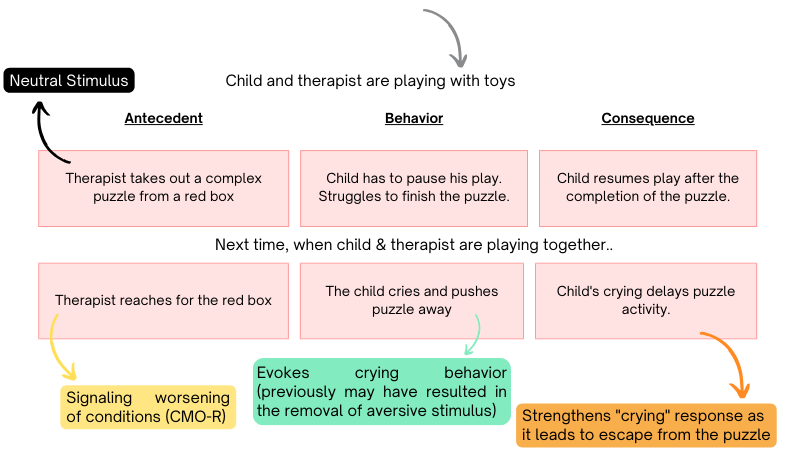How to Reduce CMO-R Effects?
Conditioned Motivating Operation-Reflexive
CMO-R refers to a signal indicating worsening of conditions, whose removal is reinforcing and it increases-
1. the value of conditioned negative reinforcement (escape).
2. behaviors that have historically resulted in the removal of that aversive signal.
This is commonly seen in the context of teaching children with autism, where instructional demands may serve as aversive stimuli, and behaviors leading to their removal may get strengthened.
Let's look at this example:
How to Reduce CMO-R Effects:
Balancing Reinforcement
Programming Competing Reinforcers:
Counteract behavior maintained by negative reinforcement (e.g., crying, screaming) by introducing positive reinforcement (e.g., offering breaks or giving tangible reinforcers) for compliant responses.
Associate tasks with Positive Reinforcement:
Enhance the teaching context by including reinforcing activities during teaching-
E.g., storytelling, singing rhymes, offering tangibles and social praise before low-probability demands.
Doing this will reduce aversiveness towards target tasks.
Managing Tasks
Fade-in Demands:
Combine easy tasks with difficult ones during sessions. This may function as an abolishing operation, reducing the value of escape as a reinforcer.
Gradually fade the rate, difficulty, and effort of demands to achieve increased instructional participation without problem behavior.
Task Variation & Novelty:
Avoid mass trialing of the same task or target.
Implement frequent task variation, which enhances skill acquisition.
Start with familiar tasks first; once you've built momentum, you can gradually introduce novel tasks.
However, it's better to maintain a balance, as high rates of novel stimuli may serve as an establishing operation/CMO-R, making escape more effective.
Giving Instructions
Errorless Instruction:
Implement errorless teaching: prompt immediately and reduce errors as it will significantly lower problem behavior and enhance learning.
Use response prompts, time delay, and intersperse responses which are more likely to occur to minimize errors while teaching.
Pace of Instruction:
Keep a faster pace of instruction using shorter Inter-Trial Intervals (ITIs).
It leads to quicker and frequent access to reinforcers; therefore, reducing the value of escape.
However, a faster pace may be less effective if demands or session duration increases.
Consider individual characteristics like off-task behavior and/or impulsivity, where a slower pace might be more effective.
Organizing Sessions
Routines & Durations:
Prioritize offering reinforcers and low-demand activities before teaching a target. This is particularly beneficial after denying other reinforcers (e.g., off-table play).
Monitor your session length and routine as well as observe the triggers of problem behavior.
Be creative with your session schedules and use a variety of activities.
Choice Making:
Allow children to make choices within instructional sessions.
When a child gets to choose an activity, the selection itself and engagement with that becomes a reinforcer.
E.g., Requesting for a break, alternative activity or terminating the activity can reduce the likelihood of escape behavior.
Watch this video that demonstrates offering choices to your learner/child.
Whether it's asking your child to eat a less preferred snack, go for a doctor’s check-up, or turn off the TV before bedtime, these aversive scenarios can make everyday learning stressful for you and your child. Applying these simple strategies, helps make learning and routines manageable and work towards a more positive, stress-free environment.
REFERENCE:
Carbone, V. J., Morgenstern, B., Zecchin-Tirri, G., & Kolberg, L. (2007). The role of the reflexive conditioned motivating operation (CMO-R) during discrete trial instruction of children with autism. Journal of Early and Intensive Behavior Intervention, 4(4), 658



